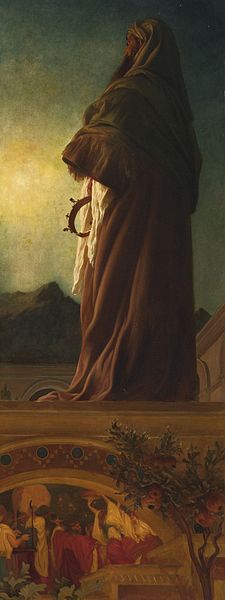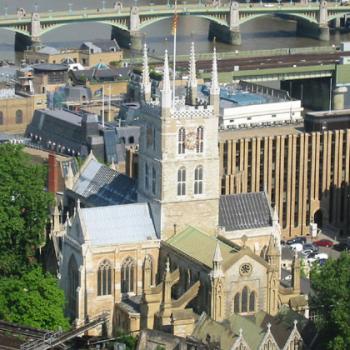
Frederic Leighton, ca. 1862
(Wikimedia Commons public domain image)
Lift up your head and be of good cheer; for behold, the time is at hand, and on this night shall the sign be given, and on the morrow come I into the world, to show unto the world that I will fulfil all that which I have caused to be spoken by the mouth of my holy prophets. (3 Nephi 1:13)
Sic et Non is absolutely rolling in the Christmas spirit. It’s difficult not to be, dealing (as we are) with an energetic Spanish-speaking three-year-old visitor for whom absolutely everything is new and exciting and — her current favorite word — a fiesta!
In that vein, I published this Deseret News column some years ago with my late, lamented friend Bill Hamblin:
Owing to the huge immigration of villagers into rapidly growing cities caused by the Industrial Revolution, traditional observance of Christmas had been declining in England since the late 1700s. Leaving their ancestral customs and social networks behind, these new urban dwellers were often poor, and they worked long and exhausting hours in increasingly mechanized factories. Moreover, their employers—of whom the fictional Ebenezer Scrooge is a fairly typical representative in this respect—weren’t especially inclined to grant them paid leave on Christmas Day. Time is money.
Writers such as Sir Walter Scott, in 1808, and the American Washington Irving, in 1820, lamented the decline of English country Christmases. But others welcomed it. Conservative reformed Protestants, for example, regarded Christmas as unbiblical, dangerously Catholic (“Christ’s mass”), and even immoral. In fact, during the brief interval when they ruled England under Oliver Cromwell in the mid-1600s, they actually abolished it—which isn’t altogether surprising, given the drunkenness, hooliganism, extravagance, and sexual license that (rather like some Mardi Gras festivities today) often accompanied rural English celebrations of Christmas in the sixteenth and seventeenth centuries.
By the 1840s, however, many Englishmen were growing nostalgic for “jolly olde England” as it had existed before the arrival of the railroad and the dirty, noisy factories (William Blake’s “dark satanic mills”) of rising industrial Britain. Charles Dickens, entering into middle age, was plainly among them. He wrote extensively and often about Christmas, far beyond the famous 1843 tale of Scrooge and those tutoring ghosts; his enormous audience demanded a Christmas article or story from him every year.
Dickens’s descriptions of Christmas plainly rest upon idealized memories of his own childhood, which was, actually, partially spent in a workhouse while his father languished in Southwark’s Marshalsea debtors’ prison. (Many of his stories are, in part, autobiographical.) A hearty meal of goose or turkey, hot wine or cider, games, dancing, sleighs, carriages, country inns, good cheer and gifts, a loving family gathered around a blazing Yule log while all is cold outside—these are images of an essentially early Victorian rural Christmas that Dickens bequeathed to us and that still, for many, form the iconic visual image of the holiday. Even our common expectation that a proper Christmas greeting card depict snow may rest, to some extent, upon the fact that, rather unusually for his native climate, his first eight childhood Christmases were white.
Curiously, Christmas cards themselves seem to have their origin at about the same time, although they didn’t really catch on and go into commercial production until about four decades later. The story is well documented: In 1843, Sir Henry Cole, too busy, he thought, to be able to write substantial Christmas letters to his friends, commissioned an artist to design decorated cards for him on which he would write brief notes. Sir Henry ordered a thousand of them—as it happened, many more than he needed—and sent the remainder to a stationer’s shop on London’s Old Bond Street for sale.
Perhaps strangely to us today, the celebrations in Dickens’s “Christmas Carol” feature no Christmas trees. German-born Queen Charlotte introduced this new element of “traditional” Christmas into the English royal household in 1800, but its popularity soared only after December 1840, when Queen Victoria’s consort Prince Albert, also from Germany, set up and decorated several trees in the royal palace. (Victoria and Albert had been married the previous February.) “That pretty German toy,” as Dickens would eventually call it, fit in very nicely with the holly and the mistletoe that had formed part of mid-winter celebrations in Britain since the fifth century.
One of the author’s sons later recalled that, for Dickens, Christmas was “a great time, a really jovial time, and my father was always at his best, a splendid host, bright and jolly as a boy and throwing his heart and soul into everything that was going on. . . . And then the dance! There was no stopping him!”
It’s very largely thanks to Charles Dickens and his England that, despite the historical origins of Christmas—probably in the spring and certainly in a Mediterranean climate—modern Americans tend to celebrate Christ’s Nativity as an idealized early Victorian mid-winter family feast. But there’s much good in the holiday customs he helped to preserve and spread, because, as Dickens himself wrote of the repentant Ebenezer Scrooge, “he knew how to keep Christmas well if any man alive possessed the knowledge.”
This is a column that I wrote for the Deseret News in 2019:
Landing this month at the international airport in Cairo, Egypt—busy gateway to a city and a nation that are roughly 85-90% Sunni Muslim—you will see Christmas decorations everywhere. And such decorations show up prominently in hotels and public spaces well beyond the airport and the city.
In Japan, where estimates put the number of Christians somewhere between one and two percent of the population or perhaps even lower, a quite secularized version of Christmas focused on Santa Claus and gift-giving is widely observed. Also prominent among Japanese Christmas traditions is eating fried chicken from KFC, where the statues of Colonel Sanders that stand in front of KFC restaurants are dressed as Santa Claus during the holiday season. Japanese people who don’t pre-order their KFC Christmas dinners can end up waiting in long lines form them, and could miss out altogether.
“Why KFC?” you might ask.
In 1970, just a few months after Takeshi Okawara opened the first KFC restaurant in Japan—he would go on to become the CEO of Kentucky Fried Chicken Japan from 1984 to 2002—he conceived the idea of a Christmas “party barrel” containing not only chicken but, in some premium cases, ribs and stuffing and cake and even wine. In 1974, the promotional campaign went national with the slogan “Kurisumasu ni wa Kentakkii” (“Kentucky for Christmas”). Since, in the 1970s, there were few if any traditional Japanese Christmas observances, KFC filled a void.
In the West, too, Christmas remains by far the dominant holiday even among those indifferent to its theological background, including many non-Christians. In increasingly post-Christian Europe, for example, the colorful Christmas markets of such cities as Krakow, Dresden, Cordoba, Berlin, Frankfurt, and Amsterdam continue to flourish. In America, scores of virtually interchangeable Christmas-themed television movies celebrate “redemption through romance” non-stop through the season, with little or (usually) no specific religious content at all.
What can explain the appeal of Christmas to people well beyond the community of committed Christian believers?
First of all, it must be recognized that a superficial view of Christmas can easily be rendered much less threatening, theologically speaking, than Easter. Everybody can accept and celebrate the birth of a baby, whereas the revivification and eventual ascent to heaven of a crucified man is difficult to reconcile with a non-Christian or even secular worldview.
It seems clear, though, that there is a very great deal, even in the most watered-down versions of Christmas (as illustrated in those television movies), that speaks to the deepest longings of human hearts around the world.
Whatever our culture or religious views, for instance, the message sung by the angels to the shepherds of Bethlehem two thousand years ago resonates with all of us: “Peace on earth, good will toward men” (compare Luke 2:14). Every Lifetime or Hallmark movie concludes with love and harmony, things for which we all yearn.
The practice of gift-giving reminds us of the generous, kind people we would like to be and among whom we would like to live. Think of the chastened and redeemed miser Ebenezer Scrooge in Charles Dickens’s 1843 novella “A Christmas Carol,” which, like the television movies that proliferate during the Christmas season, is not an explicitly Christian tale: The new Scrooge became both generous and beloved, and, as Dickens writes, “it was always said of him, that he knew how to keep Christmas well, if any man alive possessed the knowledge.”
The birth of a baby—any baby—is a moment of hope and the inauguration of virtually boundless possibilities, and Christmas powerfully reminds us of these things once more each year.
Finally, the image of the Holy Family, of the little baby snugly wrapped against the cold and lying in a manger, reminds us of the security and warmth of our own homes and families, whether as they really are or as we aspire for them to be. These are the kinds of homes and families conjured up, too, in many beloved Austrian Christmas carols and in the Victorian illustrations of father and mother and children—even Queen Victoria and Prince Albert and their young family—gathered by the hearth and around the Christmas tree, then fairly recently introduced from Germany.
We all yearn for lives of love, safety, harmony, warmth, kindness, generosity, and possibility. But this is not our world. Christmas, however, whispers that we’re strangers here, and we feel that we have wandered from a more exalted sphere.
Finally, here are some links that you might like for Christmas Eve and Christmas Day:
“The Light of Jesus Christ: A Christmas Message from President Russell M. Nelson”
Wall Street Journal: “In Hoc Anno Domini: This editorial was written in 1949 by the late Vermont Royster and has been published annually since.”
“Telling ghost stories is a lost tradition on Christmas Eve” (This article was originally published in 2010 by a brilliant young writer to whom — poor fellow! — I happen to be related.)












